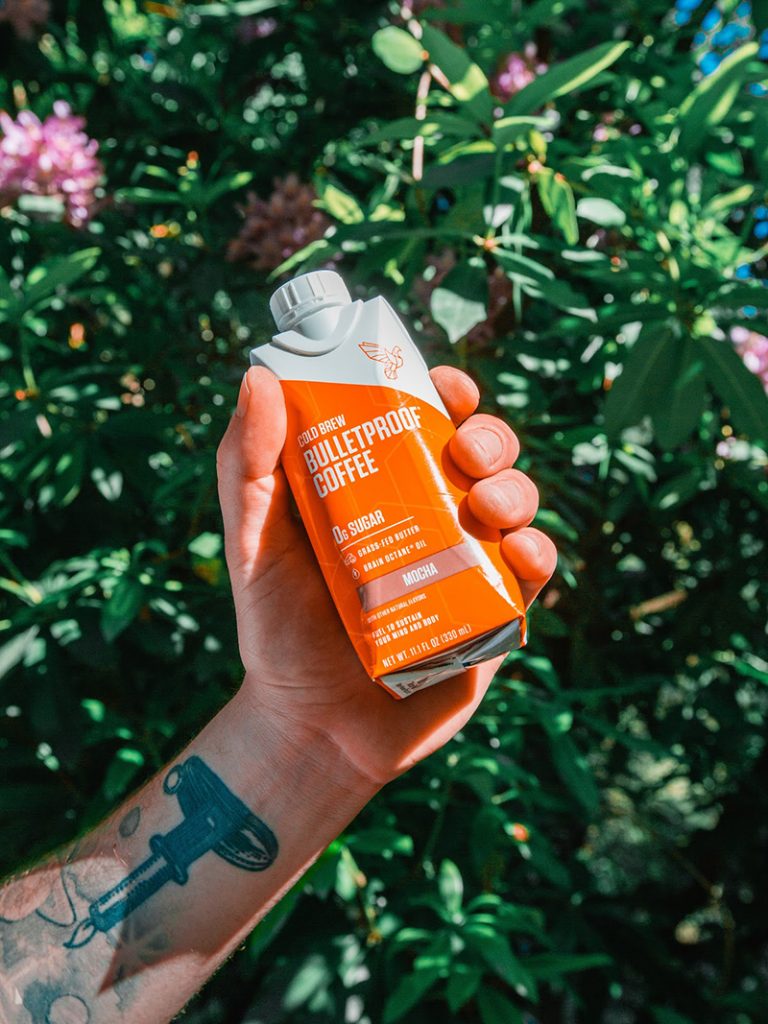Coffee trends come and coffee trends go but in recent years there’s one in particular that seems to have firmly cemented itself in the caffeine zeitgeist – butter in coffee.
What is butter coffee? There’s no mystification here – it’s exactly what it sounds like. Butter, added to your coffee (as well as some coconut oil).
I can hear the uninitiated shouting at their screens as they read this. Why would someone defile their precious black gold with a lump of animal fat? Are they nuts?!
Slow those accusations. There’s actually a few very good reasons why butter coffee, also known as Bulletproof coffee, rose to prominence, and it’s those reasons that we’re going to examine in detail below.

Butter in Coffee: The Origin Story
Butter coffee can generally trace its roots to Dave Asprey, who discovered the reinvigorating powers of the drink when he first consumed tea containing animal fat in Tibet. Recalling it, he said, “I staggered into a guest house from the -10 degree weather and was literally rejuvenated by a creamy cup of yak butter tea.”
That’s story most westerners know about butter coffee, but its origins are actually way older. The credit for its inception also lies with Ethiopia rather than America.
Ethiopia, one of the oldest coffee producing countries in the world, has been producing and consuming coffee since the 9th century. During this time, people would grind roasted beans and mix it with ghee, a type of clarified butter. This made the beans easy to carry, and could be easily consumed for a quick pick-me-up while on the go.
The Ethopians would then go on to add this ghee to their coffee drinks, as well as spices and salt to enhance the flavor. It’s this drink that would eventually evolve into the butter coffee people know and love today.

The Science on Butter in Coffee
So why exactly do people want to put butter in their coffee? Well, as we mentioned above, the current craze of butter coffee came into being because of Dave Asprey. Asprey, entrepreneur and biohacker, founded Bulletproof Nutrition Inc which promotes, among other things, the myriad health benefits of butter coffee.
Asprey’s Bulletproof coffee consists of coffee, two-tablespoons of grassfed butter and two tablespoons of medium-chain triglyceride oil or coconut oil. The result is a cup of coffee bursting with 450 calories and 50 grams of fat that Asprey claims promotes weight loss, curbs the tendency to overeat, and enhances cognitive functions.
Big claims – but what does the science say?
The Good
Butter coffee’s praise centers around its ability to do three things. Curb hunger, enhance cognitive performance, and provide a steady, low-burning source of energy. Let’s examine these claims a bit further.
Hunger

The multi-chain-triglycerides (MCTs) contained in coconut oil are actually more adept at promoting these feelings of fullness than long-chain-triglycerides found in foods like nuts and oils. MCT oil, coupled with butter, means that you’ll feel fuller for longer. Studies have also found that consuming MCTs in the morning is correlated with a reduced consumption of calories and accelerated fat loss.
Cognitive Focus

There’s also evidence to suggest that ketones can be effective in reducing the potency of neurodegenerative diseases like Alzheimer’s and Parkinson’s. However, MCTs haven’t been shown to be effective when it comes to increasing mental clarity – although that’s not to say that butter coffee doesn’t stimulate the mental faculties. One study showed that the increased mental clarity was caused by the caffeine in the coffee rather than the MCTs in coconut oil.
Energy

Butter coffee eliminates that blood sugar crash by providing a steady, longer-lasting release of energy than a traditional cup of coffee. The fats in the drink take longer to be broken down in the stomach, slowing the absorption and prolonging the effects of the caffeine.
The MCTs also play a role. They get broken down rapidly and absorbed quickly by your body, resulting in a much more sustained and steadily-released form of energy.
The Bad
It’s not all good fats and roses when it comes, like most things in life there are also potential downsides to consuming butter coffee first thing in the morning.
Lack of nutritional value

Possible stomach pains (if you’re not used to it)

Butter in Coffee isn’t for those with high cholesterol

So, Is Butter in Coffee Good or Bad?
It depends. There’s no black or white answer here, rather, the answer is dependent on the type of lifestyle you enjoy, as well as how much coffee you consume.
There’s undoubtedly benefits to the slow, sustained energy release of caffeine and MCT oil, and the propensity for weight loss that many butter coffee drinkers have enjoyed.
However, just like most things in life, the key is moderation. Substituting a nutritious breakfast for a cup of Bulletproof coffee won’t hurt if you follow a strict diet and regimen to ensure you remain healthy, but consuming multiple times a day for a sustained period of time probably isn’t too good for your heart.

Still curious? Well if you want to try…
Here’s How to Make the Perfect Bulletproof Coffee
Making butter or Bulletproof coffee is a very simple process – on top of that, it’s also creamy and delicious. Here’s what the average cup of butter coffee should contain: 30g of MCT oil, 30g of grass fed butter and around 300ml coffee. And here’s how to make it:
How to make bulletproof coffee (butter in coffee): CaffeineFiend’s Recipe
- Brew either a batch of cold brew or French press coffee.
You’ll need this in order to preserve the beneficial coffee oils that both drinks contain. You’ll want a medium to dark roast with an intense aromatic flavor in order to compliment the creamy nature of the following ingredients. - Pour it into a blender and add one to two tablespoons of MCT oil.
You can also use coconut oil if you can’t get your hands on MCT oil – they’re both very similar compounds. - Add one or two tablespoons of grass-fed butter.
If you’re lactose intolerant you can also use grass-fed ghee. Just ensure that neither option is salted – butter is going to make your coffee creamy and delicious; salt is just going to ruin it. - Mix together in the blender for around 30 seconds.
Do this until the mixture takes on the consistency of a creamy latte. Your butter coffee is ready to be served!
Things to Note:
- The great thing about butter coffee is that it’s pretty straightforward to make. Other than any normal equipment you would use to make your preferred style of coffee, the only other gadget you will need is a blender.
- You don’t even need a specific style of coffee either. Just ensure that you’re choosing a roast with a strong flavor and that you’re grinding your own beans for optimal freshness. Other than than just make sure you’re brewing with a coffee that you absolute love.
- When it comes to butter make sure that you’re using high-quality grass-fed butter. The reason for this is that butter made from the milk of grass-fed cattle contains way more nutrients than grain- or corn-fed.
- Do not, under any circumstances, use margarine. Margarine is a highly-processed substitute that was designed to look and taste like butter. It’s made using vegetable oils and contains high amounts of polyunsaturated and trans fats – two ingredients that are certainly not conducive to a healthy heart.
- If you’re wondering how often to consume butter coffee, the answer is that it depends on how you drink it. If you’re using it as a meal substitute then drinking it every morning as a meal substitute, you’ll be just fine. But if you’re pounding three or more a day, your heart and liver are probably going to want to have a word with you.

